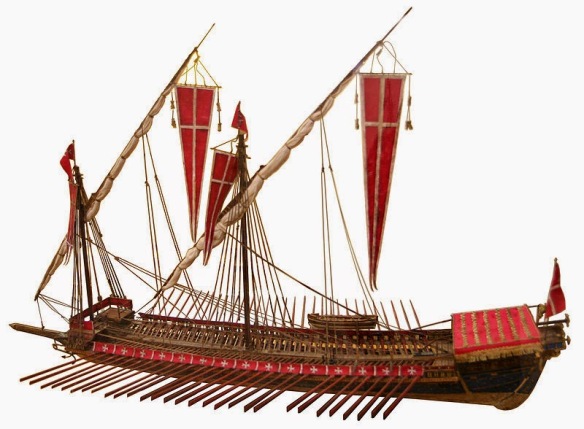The Knights of Malta at once resumed the manner of life they had already practiced for two centuries at Rhodes.
In its shipyards the Knights built and repaired their navy. They had not wasted the time spent on Cyprus and Rhodes. These island homes demanded that they master warfare on sea as well as on land, and accordingly they had developed a powerful naval force, building and equipping war galleys. Rhodes was in a strategic location in the Mediterranean, and as trade between Christian and Arab worlds had grown, the Knights found themselves in an increasingly important position.
When they first came to Malta, the Knights brought just three galleys, but their fleet was eventually expanded to total eight, plus a number of smaller ships. The Knight’s galleys had a legendary reputation for speed and manoeuvrability; they could sail very close to the wind, and their 3-foot (1 metre) draught allowed them to pursue their quarry in the shallowest water.
The Santa Anna, completed in 1524, was the most powerful warship in the Mediterranean. She carried 50 heavy cannon, and could transport and arm 600 Christian warriors. This floating fort was equipped to stay at sea for up to six months at a time. Even lesser ships of the fleet could operate through the Mediterranean winter, when storms blew the corsairs of Barbary and Malta back to port.
Later galleys sacrificed fire-power for show:
“They were superbly ornamented, gold blazed on their numerous bas-reliefs and carvings on the stern; enormous sails, striped blue and red, carried in the centre a great cross of Malta painted red. Their gorgeous flags floated majestically … Their construction, however, was little adapted either for fighting of for standing foul weather. The Order kept them as an emblem of their ancient splendour.” Luke 109
This description, though, was written in the late 18th century when the Order’s navy played a token role. In earlier years, the huge Maltese war galleys performed very practical functions.
Until 1576, they effectively sailed as part of the Spanish fleet. Together, the warships engaged the vessels of the Ottoman navy, aiming to prevent Turkish domination of the Mediterranean. Later, their role changed to that of a corsair-chaser, harassing the galleys of Barbary, and guarding Christian merchant shipping. Their effectiveness, as H.J.A. Sire points out, can be judged from the fact that Algiers became the principal base for the Barbary corsairs: it was three times as far from Malta as Tunis and Tripoli.
Not all the ships of the Order’s navy were galleys. From 1478 the Knights had been using three- and four-masted carracks (a wide-bodied ship of a design that immediately preceded the galleon) as supply vessels, to extend the range of the galley fleet, and this practice continued until the middle of the 17th century. These round ships were then abandoned until 1705, when the order began to reduce the number of galleys, replacing them with ships-of-the-line. It was with this combination fleet of galleys and round ships mixed roughly half-and-half that the Order’s navy was eventually to crush the activities of the Barbary corsairs in the late 18th century.
With a fleet which did not number more than eight galleys they resisted the Barbary pirates who infested the western basin of the Mediterranean. They formed a valuable contingent during the great expeditions of Charles V against Tunis and Algiers. Arab forces were becoming increasingly aggressive and moving west. Christians captured in these raids were being sold for ransom or as slaves. Short of funds, the Knights and Maltese become corsairs – a kind of pirate – attacking towns in North Africa and Turkish shipping. The Knights of Malta gave chase to the Turkish galleys. These enterprises did not fail to draw upon them fresh attacks from the Ottomans.
This island state is strategically located in the middle of the Mediterranean. As such, it was successively part of several ancient Mediterranean empires, including the Phoenician, Greek (ancient and Byzantine), Carthaginian, Roman, and Arab. The Normans conquered Malta in the late 11th century. It was a base for Christian armies and pilgrims heading for the ‘‘Holy Land’’ during the Crusades. When the Crusaders lost Jerusalem, and then Acre, the defeated Hospitallers retreated to Cyprus, then Rhodes. Eight years after Rhodes fell to the Ottomans (1522), Charles V resettled the Hospitallers on Malta, where they were known as the ‘‘Knights of Malta.’’ From 1564 to 1565, some 9,000 knights and retainers resisted a siege by 20,000 of Suleiman I’s assault troops, later doubled to 40,000. The fortress of St. Elmo fell but Valletta held out until disease and hunger wore down the Ottomans. Most of the defenders were also killed, with just 500 or so knights surviving. In later decades the Maltese Knights lived as pirates operating slave galleys. Styling themselves ‘‘Armies of the Religion on the Sea’’ they preyed on Muslim trade and cut Muslim throats under banners of the Virgin Mary and John the Baptist, and the famous red cross of their Order. They even acquired three island colonies in the Caribbean (Tortuga, St. Barthélemy, and St. Croix). The Grand Master was made a prince of the Empire in 1607 and in 1630 he gained rank in Rome equivalent to a Cardinal Deacon. The Knights remained in Malta until expelled by Napoleon in 1798 as he stopped off on the way to Alexandria.
